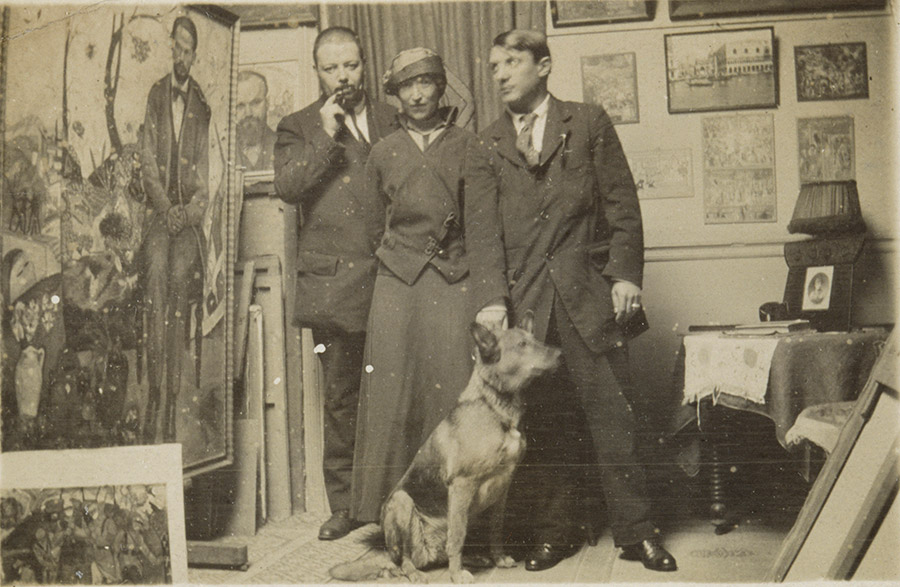A photo too quickly looked at ...
This photograph from the Musée Picasso archives was initially labelled as follows: “Ambroise Vollard, Eva Gouel and Pablo Picasso with André Derain’s dog Sentinelle – In a studio, 1914.” Ambroise Vollard was one of the first art dealers to buy Picasso’s works, from 1901 onwards. Eva Gouel was Picasso’s second companion, from 1912 to 1915, following Fernande Olivier in the artist’s love life. She died of cancer on December 14, 1915.
Yet[DB1] , the features of the woman in the hat bear little resemblance to the few known photographs of Eva Gouel, whose face was rounder, with less prominent cheekbones. The man standing to her right, whose build is roughly as thickset as Vollard’s, does not have his same look—his fair, close-cropped beard, or his more elegant dress, as one can see in Vollard’s Ingresque portrait drawn by Picasso in August, 1915.
Clearly the studio is not Picasso’s. The dog does appear to be Sentinelle, which André Derain entrusted to Picasso in Avignon on August 2, 1914, when he and Braque went off to the war.
I have tried to determine who this man and this woman were, where, by whom and when the photograph was taken—and, secondarily, why Eva was not there.
The woman looks somewhat like Marie Laurencin, who was quite close to Picasso; her figure is also similar. There are photographs of her taken in the Boulevard de Clichy studio in 1911.[1] Marie Laurencin married Otto von Wätjen, a German, on June 22, 1914. When war was declared between France and Germany over a month later, on August 3, 1914, the two were spending their honeymoon in Biarritz. On account of the marriage, Marie Laurencin had become a German citizen, and the couple was no longer welcome in France. Otto, an anti-militarist, refused to fight, as did Picasso’s dealer Daniel-Henri Kahnweiler. He was not willing to take up arms against France, the home of his new wife, nor against his country of origin, Germany. Marie and Otto took refuge in Spain and stayed there throughout the war, not to return until November 1919. Therefore, it could not possibly be Marie Laurencin, whose husband—a tall, thin young man and an elegant dresser—was entirely different from this heavy-set gentleman with a shaved head standing by the woman’s side.
The man does resemble Diego Rivera, who was quite close to Picasso from early 1914 to late 1915. He was fairly stout, and usually sported a bushy head of brown hair. He was generally considered a “giant,” standing 1.85 meters tall, whereas Picasso was rather short, at 1.63.[2] This difference in height is not apparent in the photograph, but Picasso always made sure to appear taller than he actually was by having his pictures taken from a low angle, as in this case, and placing himself slightly forward.
Diego Rivera was a Mexican painter who had come to tour Europe on a scholarship from his home country. After having visited Spain, to which he felt strong ties and where he would often return for longer stays, he arrived in France—in Paris—in March 1909. He fell in fairly easily with the artists and writers who had moved to the French capital: Mexicans, Chileans, Spaniards, and Russians. In 1913, seeing that his work was not raising much interest in Europe, Rivera realized that he had to make a shift towards new, modern, shocking, and, above all, original pieces, unlike those of other artists. Observing what he saw around him, what “made a splash,” he changed his style radically and showed a talent for Cubism. He was heavily inspired by Picasso, his “master,” and by Juan Gris, more composed and theoretical. Rivera would later say, “The greatest of the Cubists and my idol at the time was Pablo Picasso.”[3]
[1] See Anne Baldassari, Picasso Photographe, Réunion des Musées Nationaux, 1994, pp. 136-7.
[2] Information included in a police report on Picasso dated October 1917, in Pierre Daix – Armand Israël, Pablo Picasso – Dossiers de la Préfecture de Police 1901-1940, Paris and Moudon (Switzerland), Editions des Catalogues Raisonnés – Editions Acatos, 2003, p. 68.
[3] Diego Rivera (with Gladys March), My Art, My Life, An Autobiography, New York, Dover Publications (first edition 1960), 1991 p. 59. Full text available at http://survivorbb.rapeutation.com/viewtopic.php?f=178&t=916&start=0#p7694, accessed 3/5/2020.





 Summary
Summary